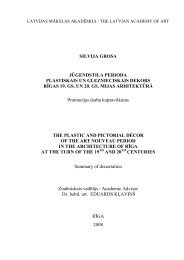Institute of Art History of the Latvian Academy of Art Anna Ancāne ...
Institute of Art History of the Latvian Academy of Art Anna Ancāne ...
Institute of Art History of the Latvian Academy of Art Anna Ancāne ...
You also want an ePaper? Increase the reach of your titles
YUMPU automatically turns print PDFs into web optimized ePapers that Google loves.
gabled houses (about 200) include <strong>the</strong> objects without later rebuilding,<br />
i.e., with <strong>the</strong> late 17 th century façade compositions, floor division,<br />
principles <strong>of</strong> proportions. The selected visual material is complemented<br />
with <strong>the</strong> information found in archival materials on <strong>the</strong> owners <strong>of</strong><br />
building plots during <strong>the</strong> 17 th century.<br />
There was a certain social hierarchy at work in <strong>the</strong> urban topography, so<br />
<strong>the</strong> pace <strong>of</strong> modernisation was different. Districts inhabited by <strong>the</strong> richest<br />
citizens were most damaged by fire and also filled with top-modern<br />
buildings. That is why in some districts – around <strong>the</strong> Town Hall, at<br />
Grēcinieku, Audēju, Kungu, Mārstaļu, Peldu Streets and between<br />
ramparts – side-gabled houses predominated much over front-gabled<br />
houses. Parts <strong>of</strong> Riga not damaged by fire retained <strong>the</strong> silhouettes <strong>of</strong><br />
front-gabled houses for a longer period, for example, at Smilšu, Aldaru,<br />
Lielā and Mazā Pils, Zirgu (up to Mazā Kalēju Street), Tirgoņu, Jaunavu,<br />
partly Miesnieku, Kaļķu Streets up to Kalēju Street. But, as time passed,<br />
dwelling houses with cornices parallel to <strong>the</strong> street increased in numbers<br />
<strong>the</strong>re as well. Changes escalated in <strong>the</strong> last decade <strong>of</strong> <strong>the</strong> 17 th century –<br />
around <strong>the</strong> turn <strong>of</strong> <strong>the</strong> century side-gabled houses outnumbered frontgabled<br />
houses.<br />
V. ARCHITECTURAL FINISH AND DÉCOR OF RIGA’S<br />
BUILDINGS IN THE 2 ND HALF OF THE 17 TH CENTURY<br />
V. 1. Façade structure and surface finish<br />
Walls <strong>of</strong> patrician houses were divided by <strong>the</strong> colossal order pilasters and<br />
o<strong>the</strong>r order elements; <strong>the</strong>y were <strong>the</strong> main bearers <strong>of</strong> architectural and<br />
decorative weight (Reutern’s House and Dannenstern’s House, 8<br />
Miesnieku Street). The lack <strong>of</strong> order elements on o<strong>the</strong>r facades was<br />
compensated with polychrome painting and imitations <strong>of</strong> pilasters or<br />
o<strong>the</strong>r details. Polychrome corner rustication, frames <strong>of</strong> window openings<br />
and decorative spandrel panels between windows also became popular.<br />
Wall finish with ashlar blocks was quite rarely found in Riga and only<br />
related to patrician houses; more wide-spread solution was a plastered<br />
façade combined with stone carvings. The question whe<strong>the</strong>r polychrome<br />
finish had existed on <strong>the</strong> natural stone facades <strong>of</strong> patrician houses<br />
requires fur<strong>the</strong>r research and comparison with <strong>the</strong> finish <strong>of</strong> similar<br />
building types in <strong>the</strong> Ne<strong>the</strong>rlands and o<strong>the</strong>r Nor<strong>the</strong>rn European countries.<br />
Finish <strong>of</strong> natural ashlar blocks had been considered self-sufficient in<br />
Riga; at 26 Jauniela <strong>the</strong> façade finish consists <strong>of</strong> two different kinds <strong>of</strong><br />
stone. In <strong>the</strong> finish <strong>of</strong> middle-class citizens’ houses, <strong>the</strong> plaster was<br />
coloured to imitate <strong>the</strong> pink-rosy tone <strong>of</strong> shelly dolomite (at 10 Audēju<br />
Street, 4 Zirgu Street, 26 Mārstaļu Street and 3/5 Jēkaba Street). Common<br />
colour combinations were white-black and white-black-red.<br />
19












